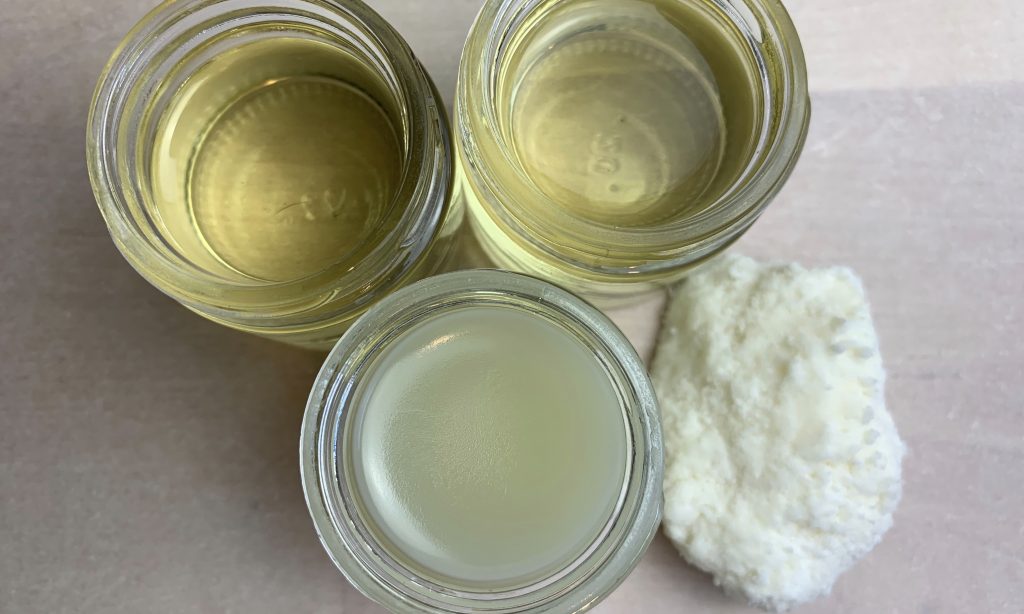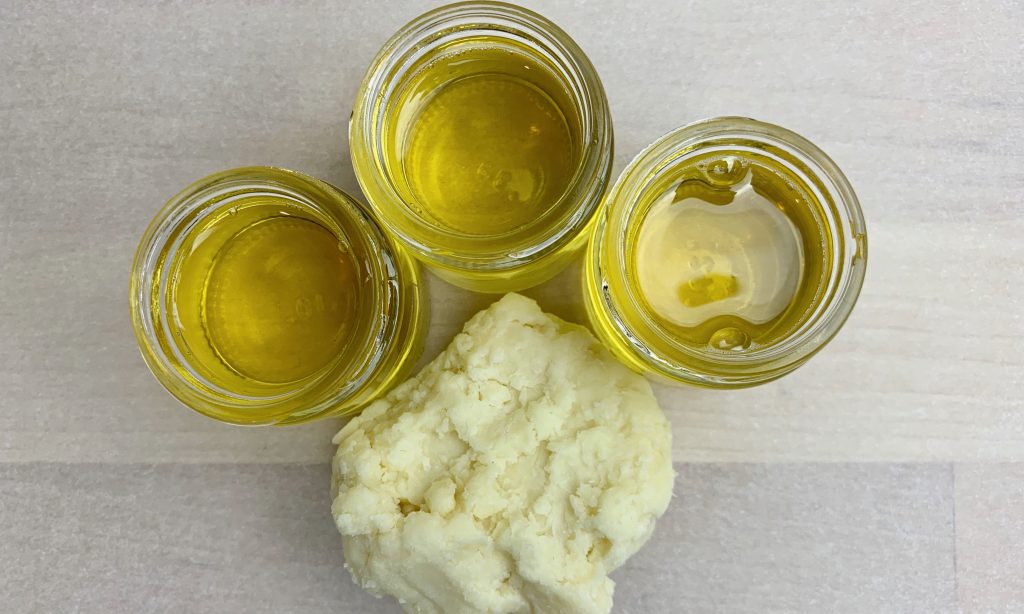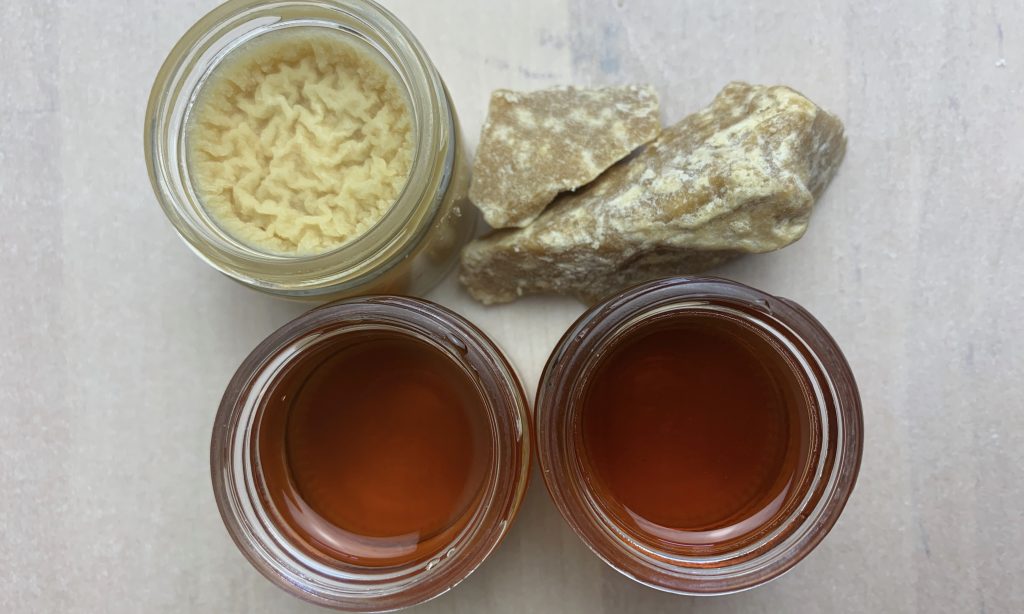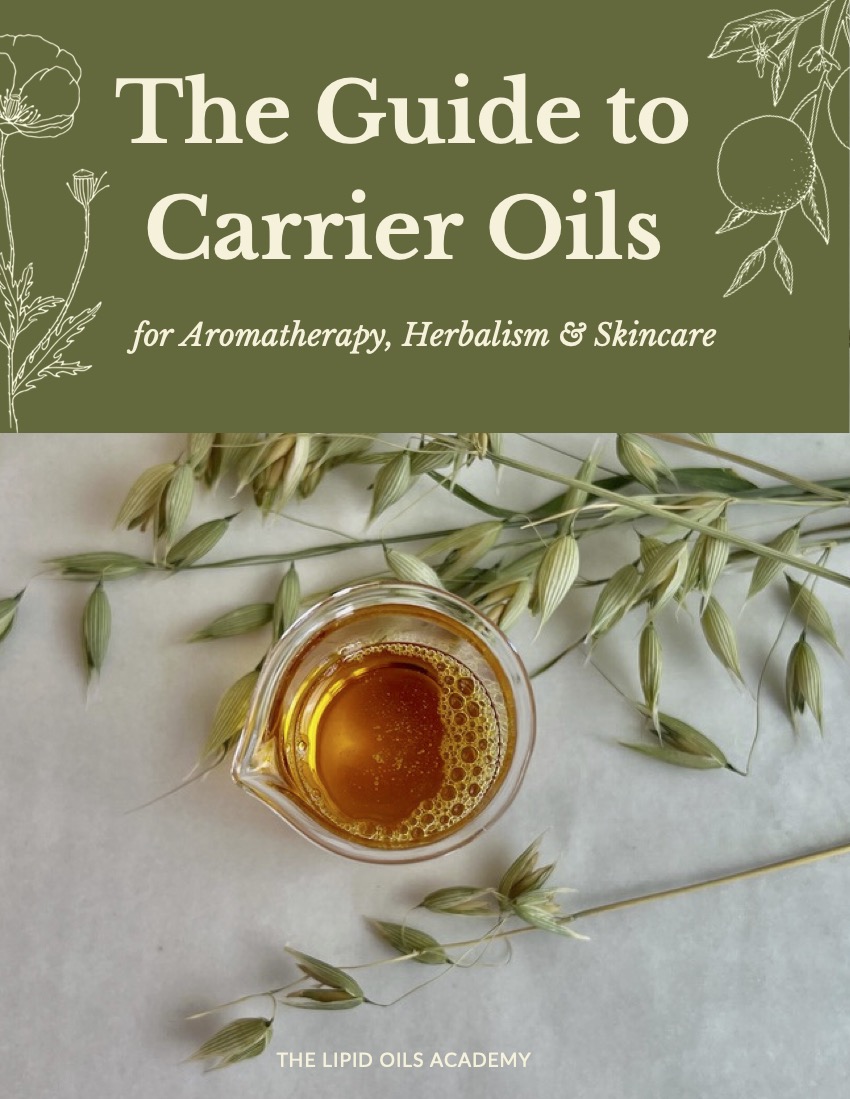Above: Uccuba butter melted and solid.
I’ve been working on a recipe for a dry balm these past few weeks.
My objective was to create a hand balm that felt light on the skin, while also moisturizing and protective.
And while it’s true that oils are known to be oily, some are actually considered “dry”.
These dry oils and butters coat the skin with a thin film of lipids that allows you to continue about your work on computer, paper or other oil sensitive materials.
In my research for this project, I focused in on finding dry butters – saturated oils that are thick and solid at room temperature – and here is a list of six that I came up with.
Babassu
Kpangnan
Murumuru
Uccuba
Also
Sal butter
Cupuaçu

I’ve split them up into two groups.
During my experiments, I found that the first group didn’t go gritty once the balm cooled.
With formulating skill the Sal butter could make an exceptional dry balm but it would take expertise and technique to get it to cool without going gritty.
Cupuaçu didn’t become objectionably gritty but I did find some evidence of roughness a few days after it cooled.
Cupuaçu, however, might be worth adding anyway. This is an interesting and unique butter that is often called “vegan lanolin”. Cupuaçu butter can absorb four times its weight in water, making it an exceptional protective lipid for the skin.

I’ve gone through a few different combinations and this is what I have found developed so far:
I have made a successful balm using equal parts Babassu, Kpangnan, Murumuru, and Uccuba butters.
I used these four butters alone without a wax to help solidify them. Because they are all saturated butters, the balm cooled solid.
This combination came out fairly solid but using just a bit on the back of a fingernail, worked into the hands felt nourishing and moisturizing without being too heavy.
To lighten it, you could add a fifth equal part of a liquid oil like camellia or hazelnut. Both these oils are considered “dry” oils so adding either one would soften the balm without making it oily.
Recipe
1 Part Babassu
1 Part Kpangnan
1 Part Murumuru
1 Part Uccuba
Optional add:
1 Part Camellia seed oil or hazelnut seed oil
Method
Melt together the four butters over low heat. I always use a cast iron saucepan as I find it distributes the heat most evenly.
Once all four butters are liquid, add the camellia seed oil or hazelnut seed oil and mix then remove the pan from the heat.
It’s always best practice to heat oils and butters as little as possible, just enough to bring them to a liquid mixable state.
Have your jars or tins ready, pour and set aside to cool before putting lids on and storing.
Have you worked with these “dry” butters yet? I’d love to hear about your experience and experiments in the comments below.



Thank you Susan much appreciated 🙂
Hello , I Have access only to Babassu butter and camellia oil , will still work ? thank you
Yes, babassu is on the dry side so along with camellia your balm will be nice and dry feeling – you may need to use a bit of beeswax to stiffen.
Hello Susan.
I made your recipe with the added carrier oil Camellia and it came out gushy. I made 2.5 oz and was thinking to remelt and add beeswax to make it more solid. What are your thoughts? What amount as well? Also, can I add essential oils for fragrance? If so, what percentage do you recommend that would not change the consistency? I am thinking 2 %. Thank you. Susan
Yes the balance of the butters to oil needs to be just right. I used only butters in the post to avoid a too soft result. But just scoop it out and add a little beeswax remelting it and you should be fine. And you can always add scent to any of my combinations, I don’t any more as I love the natural scent of the lipid butters.
Hi Susan, I just made a butter using sal butter, cocoa butter , Yellow shea butter, jojoba oil , Vitamin E,. I never work with cell butter before but I love it even if it was just that and shea butter it really is nice on the skin by the way it was not oily.
Susan, have not yet obtained Kpagnan butter. Can I substitute cupucua?
Yes you could or just leave it out – it is a fairly rare one but so lovely when it can be found. Cupuaçu is not as ‘dry’ so slightly different end result.
Susan, I source Kpagnan butter from aromatics.com. I love it! I use it in chamois balm and other products where I want to dryness.
This is fabulous – thank you so much for sharing! Excited to experiment with these.
These are all well and good, but ONLY if you can source the exotic ingredients. Please provide a source list? Otherwise this is all just a waste of time.
Hi Carol,
These two sites sell the butters in this post.
https://rainforestchica.com/
https://www.3cayg.com/
thank you Susan! both of these sources are excellent for purchasing quality ingredients 🙂
Agree
Great recipe! What I was wondering… all these butters are kind of exotic, I live in Europe and am drawn to working with more local ingredients to minimize my ecological footprints do we even have any butters or can we create butterlike structures by adding stearic acid and cetyl alcohol for instance?
Hi Sandra, Butters by their nature are from plants that grow in the tropics regions. And yes you could thicken liquid oils like camellia or hazelnut to make balms using the solid alcohols, etc. Have fun formulating.
Do you have a source you recommend for purchasing these exotic butters. Some of these I’ve not seen available from my normal suppliers.
Hi Cynthia,
I get a lot of my butters from Rainforest Chica and 3KayG.
Here’s the links
https://rainforestchica.com/
https://www.3cayg.com/
Could we whip them like hand butter?
Yes, certainly.
The only butter I don’t have is the Kpangnan butter. Would mango or cocoa butter work? Or maybe just double up on one of the others?
For the dry effect I was going for, leave out the kpangnan butter of this combination. It is fairly rare but becoming more available with time.The others in the recipe are all sufficiently dry feeling on the skin.
Hello Susan
What will be the measurement of these butters and oil in percentage ?
Equal parts means whatever you decide you want say 40 grams that would be 4 parts 10 grams each =40 grams
80 grams , 4 parts 20 grams each (4 x 20=80 grams and so on
So each butter or oil is a part all equal in weight
Hope that helps
Thank you ,Lynn
Hi Susan! I haven’t worked with any of the butters above but it’s on my list to try next. I was wondering if you have some tips for those butters that go grainy after cooling. I’ve been making a balm with Cocoa butter, coconut oil, avocado oil and bees wax; some essential oils too but I keep getting these grains after few days and even more after few weeks, it’s driving me crazy!! I have tried different cooling times, temperatures to add EO… etc I’m out of ideas, hope you can give me some light!!! Thanks! ☺️
Have you tried melting the hardest butter first and adding the softer ingredients last? That has worked for me.
Hello Susan. Ive just loved learning about this. I am in the UK and I don’t seem to be able to source the kpangan butter – Im wondering would shea butter be an alternative.
Try a company called Shea Butter Cottage. They are located in the UK I believe and have lots of exotic oils and butters.